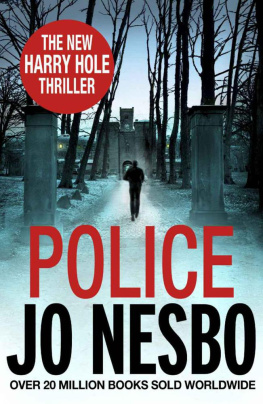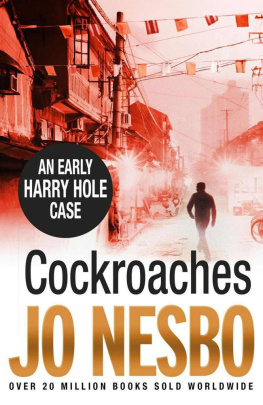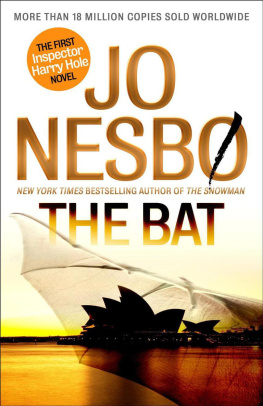Jo Nesbo - The Devil's star
Here you can read online Jo Nesbo - The Devil's star full text of the book (entire story) in english for free. Download pdf and epub, get meaning, cover and reviews about this ebook. genre: Detective and thriller. Description of the work, (preface) as well as reviews are available. Best literature library LitArk.com created for fans of good reading and offers a wide selection of genres:
Romance novel
Science fiction
Adventure
Detective
Science
History
Home and family
Prose
Art
Politics
Computer
Non-fiction
Religion
Business
Children
Humor
Choose a favorite category and find really read worthwhile books. Enjoy immersion in the world of imagination, feel the emotions of the characters or learn something new for yourself, make an fascinating discovery.

- Book:The Devil's star
- Author:
- Genre:
- Rating:4 / 5
- Favourites:Add to favourites
- Your mark:
- 80
- 1
- 2
- 3
- 4
- 5
The Devil's star: summary, description and annotation
We offer to read an annotation, description, summary or preface (depends on what the author of the book "The Devil's star" wrote himself). If you haven't found the necessary information about the book — write in the comments, we will try to find it.
The Devil's star — read online for free the complete book (whole text) full work
Below is the text of the book, divided by pages. System saving the place of the last page read, allows you to conveniently read the book "The Devil's star" online for free, without having to search again every time where you left off. Put a bookmark, and you can go to the page where you finished reading at any time.
Font size:
Interval:
Bookmark:
The Devil's Star
Jo Nesbo
Part One
1
Friday. Egg.
The house was built in 1898 on a clay base that had since sunk a tiny bit on the west-facing side, causing water to cross the wooden threshold where the door was hung. It ran across the bedroom floor and left a wet streak over the oak parquet, moving west. The flow rested for a second in a dip before more water nudged it from behind and it scurried like a nervous rat towards the skirting board. There the water went in both directions; it searched and somehow sneaked under the skirting until it found a gap between the end of the wooden flooring and the wall. In the gap lay a fivekroner coin bearing a profile of King Olavs head and the date: 1987, the year before it had fallen out of the carpenters pocket. But these were the boom years; a great many attic flats had needed to be built at the drop of a hat and the carpenter had not bothered to look for it.
It did not take the water much time to find a way through the floor under the parquet. Apart from when there was a leak in 1968 the same year a new roof was built on the house the wooden floorboards had lain there undisturbed, drying and contracting so that the crack between the two innermost pine floorboards was now almost half a centimetre. The water dripped onto the beam beneath the crack and continued westwards and into the exterior wall. There it seeped into the plaster and the mortar that had been mixed one hundred years before, also in midsummer, by Jacob Andersen, a master bricklayer and father of five. Andersen, like all bricklayers in Oslo at that time, mixed his own mortar and wall plaster. Not only did he have his own unique blend of lime, sand and water, he also had his own special ingredients: horsehair and pigs blood. Jacob Andersen was of the opinion that the hair and the blood held the plaster together and gave it extra strength. It was not his idea, he told his head-shaking colleagues at the time, his Scottish father and grandfather had used the same ingredients from sheep. Even though he had renounced his Scottish surname and taken on a trade name he saw no reason to turn his back on six hundred years of heritage. Some of the bricklayers considered it immoral, some thought he was in league with the Devil, but most just laughed at him. Perhaps it was one of the latter who spread the story that was to take hold in the burgeoning town of Kristania.
A coachman from Grunerlokka had married his cousin from Varmland and together they moved into a one-room flat plus kitchen in one of the apartment blocks in Seilduksgata that Andersen had helped to build. The couples first child was unlucky enough to be born with dark, curly hair and brown eyes, and since the couple were blond with blue eyes and the man was jealous by nature as well late one night he tied his wifes hands behind her, took her down to the cellar and bricked her in. Her screams were effectively muffled by the thick walls where she stood bound and squeezed between the two brick surfaces. The husband had perhaps thought that she would suffocate from lack of oxygen, but bricklayers do allow for ventilation. In the end, the poor woman attacked the wall with her bare teeth. And that might well have worked because as the Scottish bricklayer used blood and hair, thinking that he could save on the expensive lime in the cement mix, the result was a porous wall that crumbled under the attack from strong Varmland teeth. However, her hunger for life sadly led to her taking excessively large mouthfuls of mortar and brick. Ultimately she was unable to chew, swallow or spit and the sand, pebbles and chunks of clay blocked her windpipe. Her face turned blue, her heartbeat slowed and then she stopped breathing.
She was what most people would call dead.
According to the myth, however, the taste of pigs blood had the effect of making the unfortunate woman believe she was still alive. And with that she immediately broke free of the ropes that bound her, passed through the wall and began to walk again. A few old people from Grunerlokka still remember the story from their childhood, about the woman with the pigs head, walking around with a knife to cut off the heads of small children who were out late. She had to have the taste of blood in her mouth so that she didnt vanish into thin air. At the time very few people knew the name of the bricklayer and Andersen worked tirelessly at making his special blend of mortar. Three years later, while working on the building where the water was now leaking he fell from the scaffolding leaving only two hundred kroner and a guitar and so it was to be another hundred years before bricklayers began to use artificial hair-like fibres in their cement mixes and before technicians at a laboratory in Milan discovered that the walls of Jericho had been strengthened with blood and camel hair.
Most of the water, however, did not run into the wall, but down it, because water, like cowardice and lust, always finds the lowest level. At first the water was absorbed by the lumpy, granular insulation between the joists, but more followed and soon the insulation was saturated. The water went right through it and soaked up a newspaper dated July 11, 1898, in which it said the building industrys boom time had probably reached its peak and the unscrupulous property speculators were sure to have harder times ahead. On page three it said that the police still had no leads regarding the murder of a young nurse who had been found dead from stab wounds in a bathroom the previous week. In May, a girl mutilated and killed in a similar way was found near the River Akerselva, but the police would not say whether the two cases could be connected.
The water ran off the newspaper, between the wooden boards underneath and along the inside of the painted ceiling fabric of the room below. Since this had been damaged during the repair of the leak in 1968, the water seeped through the holes, forming drops that hung on until they became heavy enough for gravity to defy the surface tension; they let go and fell three metres and eight centimetres. There the water landed and terminated its trajectory. Into water.
Vibeke Knutsen sucked hard on her cigarette and blew smoke out of the open window on the fourth floor of the apartment building. It was a warm afternoon and the air rose from the sun-baked asphalt in the back yard, taking the smoke up the light blue house front until it dispersed. On the other side of the roof you could hear the sound of a car in the usually busy Ullevalsveien. But now everyone was on holiday and the town was almost deserted. A fly lay on its back on the windowsill with its six feet in the air. It hadnt had the sense to get out of the heat. It was cooler at the other end of the flat facing Ullevalsveien, but Vibeke didnt like the view from there. Our Saviours Cemetery. Crowded with famous people. Famous dead people. On the ground floor there was a shop selling monuments, as the sign said, in other words, headstones. What one might call staying close to the market.
Vibeke rested her forehead against the cool glass of the window.
She had been happy when the warm weather came, but her happiness had soon worn off. Even now she was longing for cooler nights and people in the streets. Today there had been five customers in the gallery before lunch and three after. She had smoked one and a half packets of cigarettes out of sheer boredom. Her heart was pounding and she had a sore throat; in fact, she could hardly speak when the boss rang and asked how things were going. All the same, no sooner had she arrived home and put the potatoes on than she felt the craving in the pit of her stomach again.
Vibeke had stopped smoking when she met Anders two years before. He hadnt asked her to. Quite the contrary. When they met on Gran Canaria he had even bummed a cigarette off her. Just for a laugh. When they moved in together, just one month after getting back to Oslo, one of the first things he had said was that their relationship would probably be able to stand a little passive smoking, and that cancer researchers were undoubtedly exaggerating. With a little time he would probably get used to the smell of cigarettes on their clothes. The next morning she made up her mind. When, some days later, he mentioned over lunch that it was a long time since he had seen her with a cigarette in her hand, she answered that she had never really been much of a smoker. Anders smiled, leaned over the table and stroked her cheek.
Font size:
Interval:
Bookmark:
Similar books «The Devil's star»
Look at similar books to The Devil's star. We have selected literature similar in name and meaning in the hope of providing readers with more options to find new, interesting, not yet read works.
Discussion, reviews of the book The Devil's star and just readers' own opinions. Leave your comments, write what you think about the work, its meaning or the main characters. Specify what exactly you liked and what you didn't like, and why you think so.













